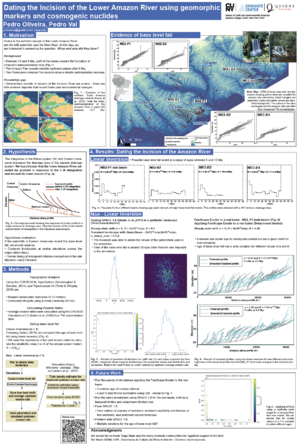2025 CSDMS meeting-032
From CSDMS
(if you haven't already)
Log in (or create account for non-CSDMS members)
Forgot username? Search or email:CSDMSweb@colorado.edu
Browse abstracts
“Dating the Incision of the Lower Amazon River using geomorphic markers and cosmogenic nuclides”
Pedro Oliveira,
Queens College CUNY New York City New York, United States. poliveira@gradcenter.cuny.edu
Pedro Val, Queens College CUNY New York New York, United States. pval@qc.cuny.edu
The Amazon River Basin stands out as the most biodiverse system in the world. However, the period when the river started flowing from the Andes to the Atlantic Ocean is still in large debate. Different studies have dated this period from the Late Miocene to the Pleistocene. The lack of a Miocene sedimentary record in the area, along with the limitations of geochronological tools that reach this timescale for shallow deposits, makes it difficult to date the event using onshore sediments, which suggests a possible Miocene age. In this study, we seek to contribute to this knowledge gap by using the landscape to reconstruct the timing of transcontinentalization. We hypothesize that when the proto-Amazon River (eastern) integrated with the western Amazon River system, it led to an increase in drainage area at the Lower Amazon River. This increase must have caused the incision of its substrate, thus lowering the base level of its tributary basins in eastern Amazonia. The lowering caused the propagation of knickpoints in the tributary basins that have been adjusting to the new base level. Widespread waterfalls at common elevations and area-corrected distances in basins provide geomorphic evidence of such base level fall. We collected 20 samples of Be-10 and 6 of Al-26, which can be used to infer erosion rates in these tributary basins. These data reveal erosion rates from 8 to 12 m/Ma. Combining these rates with the channel steepness, we obtained a value of erosional efficiency (stream power’s K) for the region. This value of 2.28 m0.1 yr-1 was used in a linear inversion of the stream power equation to obtain a base level fall age. Preliminary results showed an age estimated around 5 to 10 Myr for the formation of knickpoint clusters, thus within the time window of the commonly proposed Amazon River’s formation. However, this approach relies on linearity to calculate the stream power erosion, and it is best suited for bedrock rivers. We explore how these assumptions (i.e. n=1 and detachment-limited), influence our results by inverting a landscape model using the SPACE 1.0 component (transport and detachment-limited river-based modeling) applied to the Simulation-based inference toolkit to find best-fit sediment-transport and deposition parameters. We then compare the age solutions with the age of the linear inversion, ultimately to assess the uncertainty around the age of the latest base-level fall in the Amazon River.

